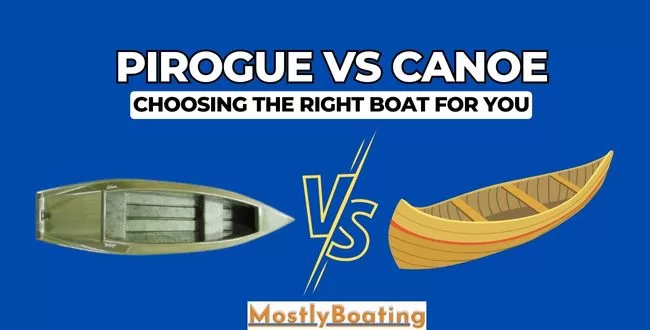So you’re here after searching for a query ‘Pirogue vs Canoe’. For sure, when you’re exploring different options to navigate waterways, the debate between these two watercraft can hardly be overlooked.
So what’s the difference between canoe vs pirogue?
Simply put, a canoe is a long, narrow boat that’s usually propelled with a single-bladed paddle. Meanwhile, a pirogue is simply a type of canoe that requires the usage of paddles or poles for propulsion. The major difference between the two is their shape. Canoes are pointed at both ends, while pirogues have tapered ends.
With that said, let’s dig deeper into canoes vs pirogue, along with some additional information you would love to know.
So be with us till the end!
Key Takeaways on Comparison between Pirogue vs Canoe
What is a Cajun Pirogue Boat – Cajun Pirogue is a traditional boat that falls into the category of the canoe. As the name suggests, the watercraft was originally used by the Cajun people for transportation and fishing purposes. It contains a cloth that’s responsible to provide balance in waterways.
What are the key differences between them
Shape: Canoes are open-top vessels with pointed ends. It usually contains a round-bottomed hull with higher sides. On the other hand, Pirogues have tapered ends and typically possess a flat-bottomed hull design.
Propulsion: As mentioned, a canoe is propelled by a single-bladed paddle, while a pirogue is commonly propelled using poles.
Seats: A canoe typically has bench-like seats that run across the width of the canoe/boat. In contrast, pirogues have a simple seating arrangement. The seats in a canoe are placed slightly higher off the waterline compared to those present on a pirogue.
Intended Use: Canoes are often used for long water tours, recreational activities, camping, and racing. The pirogues, oppositely, are tailored for specific purposes like transportation of cargo and fishing.
Stability: Being narrow, canoes offer excellent stability. It’s because they have a round-bottomed hull and high-profile design. Pirogues, in comparison, are simply less stable and that’s all due to their low-profile structure.
Which one is best for me – The best watercraft between the canoe vs pirogue boils down to your needs and preferences. For instance, if you plan to have some recreational fun, a canoe is ideal for you. However, in case you need to do fishing or transport cargo, a pirogue is the way to go, though people also use freighter canoe.
What is Pirogue?
Pirogue, also called dugouts, is basically a traditional watercraft that falls under the category of canoe. It is well-suited for navigating narrow and marshy waters due to its shallow draft and stability.
Moving forward, the watercraft can handle rough conditions to some extent. That said, it’s primarily used to transport bulky cargo and fishing.
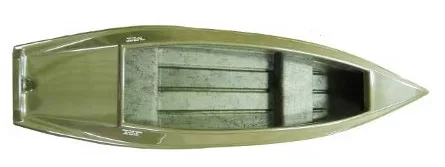
In terms of construction, the pirogues are often carved out of two cypress logs (wood pieces) or marine plywood.
Moreover, pirogues require the use of poles for propulsion. The poles can either be single-bladed or double-bladed.
Is Pirogue a Boat?
Native to West Africa and parts of the Caribbean, the pirogue is indeed a boat with tapered ends. It has a shaft-like structure and is commonly known as an ‘old-fashioned’ boat.
The watercraft has a cloth that flutters when the wind blows. This cloth helps maintain balance, enabling it to navigate rough conditions effectively.
What are some famous pirogue companies?
There are numerous pirogue manufacturers in the market. Considering that, it’s quite difficult to find the best quality.
Don’t worry, as we have mentioned below some of the best pirogue manufacturers you should consider when making a purchase:
- Bandit Boats
- Pintail Pirogue
- Outriggers Pirogues
- Resiglas Nautical
Advantages/Disadvantages of Pirogue
If you plan to purchase a pirogue, considering its pros and cons is paramount beforehand.
Here’s a chart outlining the major advantages and disadvantages of Pirogue:
| Advantages | Disadvantages |
| Navigates shallow waters easily | Less stability in rough waters |
| Maneuverable and agile | Lack of amenities for comfort |
| Eco-friendly propulsion mechanism | Slow speed |
| Suitable for transportation of bulky cargo | Limited protection from weather elements |
| Silent operation | – |
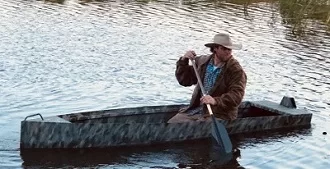
What is Canoe?
A canoe is a narrow watercraft that has been in existence for centuries. With pointed ends and an open deck design, this watercraft is best for recreational purposes, canoe camping, racing, etc.
With regard to propulsion technique, a canoeist has to put in hand effort to propel a canoe. While paddling the canoe, the one who’s riding the ship should face toward the front or bow of the canoe.
Additionally, a canoe has a high-profile design, which means it’s far more stable than other small boats like pirogues. It indicates that even a newbie rider can handle the aquatic watercraft without any trouble.
Advantages/Disadvantages of Canoe
After knowing all about canoes, it’s time to have a look at some pros and cons of this watercraft. Here are a few major ones:
| Advantages | Disadvantages |
| Minimal maintenance required | Vulnerable to weather changes |
| Faster than pirogue | Unstable in waves |
| Compact design | Limited seats |
| Suitable for recreational activities | Requires more effort when solo paddling |
| Excellent source of workout |
Difference Between Pirogue vs Canoe
If you tend to hop on an aquatic trip, you have probably thought about the best watercraft between canoe vs pirogue. So how to determine that?
For your ease, we have listed down a few major differences between these two boats:
Methods of Propulsion:
Canoes: As outlined above, canoes require one to utilize a single-bladed for propulsion. Canoeists can either kneel or sit back in the vessel for movement.
Pirogues: When it comes to pirogues, poles or paddles are the basic component needed for propulsion. The rider has to face the front of the boat and keep their legs firmly placed at the bottom for efficient movement.
Stability:
Canoes: The boat offers an upper hand with regard to stability. It is designed with a high-profile design in mind. The result? Low center of gravity and eventually increased stability.
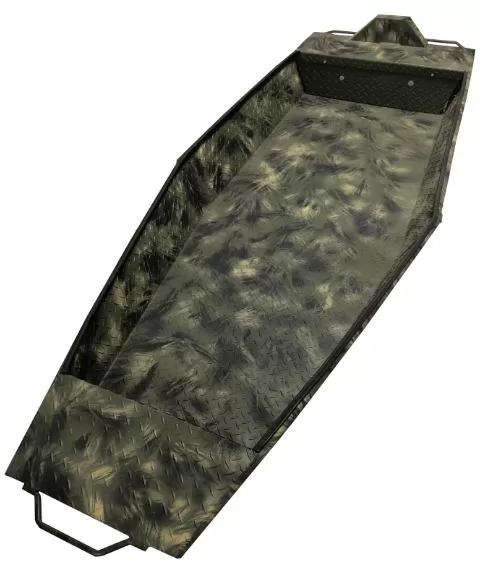
Pirogues: Relatively, these watercraft are not very stable. And that’s all due to their low-profile structure and higher center of gravity.
Hull Shape and Design:
Pirogue: Pirogues typically have a flat-bottomed hull that is wider and more stable, which allows them to be used in shallower waters and provides better stability for activities like fishing and hunting. The hull is often made from a single large piece of wood or other materials.
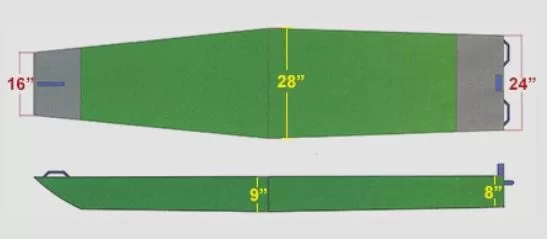
Canoe: Canoes usually have a more pointed, V-shaped hull that cuts through the water with less resistance. This design makes canoes more suitable for faster and more efficient paddling, making them better suited for recreational paddling and longer trips.
Materials and Construction:
Pirogue: Traditional pirogues were often constructed using single logs that were hollowed out. In modern times, they can be made from a variety of materials, including wood, aluminum, fiberglass, or plastic.
Canoe: Canoes can also be constructed from a range of canoe materials, such as wood, aluminum, fiberglass, Kevlar, and plastic. The choice of material can affect the weight, durability, and performance of the canoe.
Similarities Between Canoe vs Pirogue
Let’s move on to a few similarities between pirogue vs canoe:
- Both boats require low maintenance, as there are no motors or other technical components.
- Due to their non-motorized propulsion (typically paddles), both types of watercraft are eco-friendly.
- Both vessels rely on human power for propulsion on the waterways.
Comparison of Speed & Maneuverability Between Pirogue vs Canoe
Canoes are lighter than pirogue, so you can expect them to be faster. The elongated shape and sleek design of these vessels allow for impressive speed, and their pointed bows facilitate smooth tracking.
On the other hand, the pirogue contains a flat bottom and wide hull. This design prioritizes ease of navigation over speed.
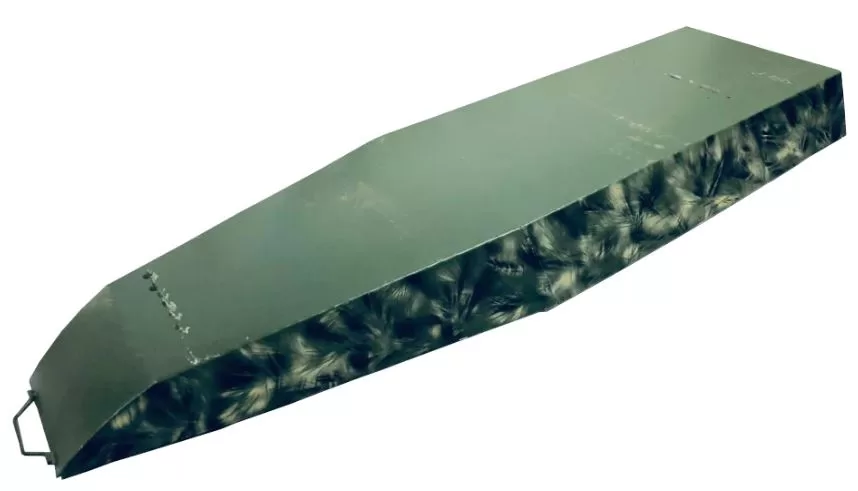
Comparison of Weight Limit & Portaging
The average weight limit of both the vessels depends upon factors like their length, construction material, etc.
For instance, a 16-inch canoe can bear up to 940 pounds easily. Similarly, the capacity reduces when it comes to a 14-inch canoe that is capable of holding just 700 pounds. And if you want more people to join the trip, a 17-inch canoe with a weight limit of 1160 pounds can be the best pick.
On the other hand, pirogues can hold much lesser weight in comparison to canoes, ranging between 300 to 600 pounds in general.
Although lightweight portaging pirogues can be a challenging feat. It’s because their flat bottom and broader shape pose a hindrance to proper weight distribution.
Meanwhile, canoes have a more streamlined body, making canoe easier to transport overland. And the canoe carrying handles come as a plus point facilitating even weight distribution on the shoulders.
Comparison of Safety and Ease of Usage
Coming to their safety, both canoes and pirogues remain stable if used within their intended conditions. However, if you opt for a traditional pirogue, keeping it balanced might require effort due to its less stable hull. This specifically applies when the water conditions are rough.
Moving on, if we compare both watercrafts’ ease of use, a canoe is the clear winner here. It’s because the pointed front and symmetrical design ensures better responsiveness to the paddling strokes, allowing seamless control over direction.
However, pirogues might not be as straightforward to operate as their broader shape, and variations in weight distribution call for the need for more nuanced strokes and adjustments for smoother navigation.
Comparison of Cost & Availability of Parts
The average cost of a canoe ranges between $600 to $1,500, depending on the brand. In comparison, pirogues are available at economical rates ranging between $90 to $270. However, some high-end models can cost you a bit more than this.
Additionally, both canoe and pirogue parts are easily available for replacement. But, it can depend upon the brand and model as well. You might have difficulty finding them for rare ones.
Which one is better in different conditions?
If you are confused between choosing a canoe and a pirogue, let us make it easier for you depending on your needs.
Solo
When embarking on a solo trip, canoes can be a better pick over pirogues. The balanced shape of this vessel allows easy maneuverability when paddled by a single person.
Tandem
For tandem paddling, both canoes and pirogues can work fine. However, we would prefer canoes for their equal weight distribution quality with two persons on board.
Family
Since canoes have a higher weight-holding capacity than pirogues, they are a much better option than choosing a canoe for a family trip. Moreover, the extra space facilitates comfortable seating.
Specific Considerations for Different Materials
Wood:
Wooden canoes and pirogues require special care to preserve their natural beauty and structural integrity.
- Sealing and Varnishing: Apply marine-grade sealant and varnish to protect the wood from water penetration and UV rays. Reapply as needed, following the manufacturer’s recommendations.
- Regular Inspection: Check for any signs of rot or decay. If you notice soft spots or discolouration, address them immediately.
- Dry Storage: Wooden watercraft should be stored in a climate-controlled environment to prevent warping or cracking.
Aluminium:
Aluminium canoes and pirogues are known for their durability but benefit from attention to a few key areas.
- Anti-Corrosion Treatment: Apply an anti-corrosion treatment to prevent oxidation. Focus on areas prone to contact with water, such as joints and rivets.
- Scratch Repair: Address scratches promptly by using touch-up paint to prevent the development of rust.
- Rinse After Saltwater Use: If used in saltwater, rinse the aluminium watercraft thoroughly with fresh water to remove salt deposits.
Fiberglass:
Fibreglass canoes and pirogues balance strength and weight but require specific care.
- Gel Coat Protection: Protect the gel coat by applying a wax or polish for fibreglass. This enhances the finish and shields against UV damage.
- Avoid Impact: Fiberglass can be prone to cracking upon impact. Navigate carefully, especially in shallow waters.
Repair Chips and Cracks: Promptly address any chips or cracks in the fibreglass with a suitable repair kit to maintain structural integrity.
FAQs – Pirogue vs Canoe
Can we add outriggers on pirogue?
Yes, outriggers can be added to a pirogue for increased stability. Canoe Outriggers are sided extensions that help prevent canoe tipping over, making the pirogue more secure for various activities on the water.
Can we install a trolling motor on both of them?
Yes, you can install an outboard trolling motor on both canoes and pirogues. However, you need to make sure that the trolling motor is compatible with the boat model.
Which one is better for fishing?
Pirogues are better suited for fishing in comparison to canoes. While you can cast a reel in a canoe as well, a pirogue will allow you to explore exclusive fish areas more easily.
Can you use a pirogue and a canoe in both calm and rough waters?
No, canoes and pirogues can’t be used in both calm and rough waters. A canoe is a specially designed watercraft that’s ideal to ride in calm waters such as lakes and rivers. On the other hand, pirogue can handle rough conditions and thus, is ideal for rough water bodies.
Which one can be greatly customized?
Canoes can be greatly customized in comparison to a pirogue. It’s spacious and contains storage options to store essential amenities. However, pirogue is a simple design boat that doesn’t contain such features.

Jack Bennett, a passionate pedal boating enthusiast, and marine engineer by day, is here to share my knowledge and love for this exciting sport with you all. Happy Boating!
